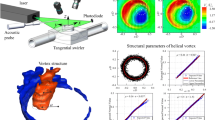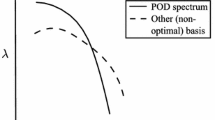Abstract
A correlation technique is tested, which enables the identification of flow structures that are involved in sound generation processes. At first, the method is applied to the problem of induced noise from flow over a cylinder. The velocity field around a circular cylinder is measured by particle image velocimetry (PIV), while the radiated sound is recorded with a microphone. Both measurements are conducted in a synchronized manner so as to enable the calculation of the cross-correlation between velocity or vorticity fluctuations and the acoustic pressure. The therewith obtained coefficient matrix provides time- and space-resolved information about the statistical dependency between flow structures and the acoustic pressure. Furthermore, a proper orthogonal decomposition (POD) is applied to the velocity field. Then the correlation between dominating modes and the acoustic pressure is computed to identify which modes are mainly involved in the sound generation. Finally, the developed method is applied to the more applied problem of the flow-field inside a leading-edge slat-cove. The results show that, in this case, the signal-to-noise ratio is too low to allow an identification of noise-relevant flow structures, as opposed to the case of the cylinder wake flow, where 5,000 PIV recordings were sufficient to identify the flow structures, which are involved in the noise-generation process. A maximum in spatial distribution of the cross-correlation coefficient is observed 1.6 diameters downstream of the cylinder; its value decreases as one moves further downstream. In this area of maximal correlation, a rapid acceleration of the released vortices takes place. The cross-correlation coefficient fluctuates over time in a sine-type oscillation with maximum values of about \(|R_{v^{\prime}p^{\prime}}| = 0.2.\) \(R_{u^{\prime}p^{\prime}}\) and \(R_{v^{\prime}p^{\prime}}\) show a periodic behavior with a phase shift of π/2 with respect to each other. These regular oscillations can be explained by coherent periodic structures in the flow-field. These structures generate a sound field with the same periodicity, which is perceived as tone. Hence, the correlation between the velocity fluctuations and the acoustic pressure show oscillations identical to those of the input signals. A filtering of uncorrelated noise can be observed; this being caused by the averaging process during the cross-correlation calculation. The correlation with the eigenmodes of a POD gives correlation coefficients, which are no larger than the correlation with a local near-field quantity.













Similar content being viewed by others
Abbreviations
- a(m):
-
amplitude of mode m
- α :
-
angle of attack
- c :
-
cord length
- d :
-
cylinder diameter
- f :
-
frequency
- f s :
-
sampling frequency
- H :
-
height of the test section
- n :
-
index of PIV snapshot
- λ :
-
eigenvalue
- N :
-
number of snapshots by PIV
- W :
-
width of the test section
- ω z :
-
out of plane vorticity
- ψ :
-
eigenmode
- p′:
-
sound pressure
- ϕ :
-
flow quantity
- Re :
-
Reynolds number
- SPL:
-
sound pressure level
- σ :
-
RMS-value
- S t :
-
Strouhal number
- t :
-
time
- τ :
-
time difference
- u, v :
-
velocity components with respect to x, y, respectively
- U ∞ :
-
free stream velocity
- x, y :
-
Cartesian coordinates of the PIV plane
References
Ausseur J, Pinier J, Glauser MN (2006) Flow separation control using a convection based POD approach. In: Third AIAA Flow Control Conference, San Francisco, 5–8 June 2006, Meeting Papers, AIAA paper 2006-3017
Berkooz G, Holmes P, Lumley J (1993) The proper orthogonal decomposition in the analysis of turbulent flows. Annu Rev Fluid Mech 25:539–75
Borée J (2003) Extended proper orthogonal decomposition: a tool to analyse correlated events in turbulent flows. Exp Fluids 35:188–192
Chatellier L, Fitzpatrick J (2005) Spatio-temporal correlation analysis of turbulent flows using global and single-point measurements. Exp Fluids 38:563–575
Clark PJF, Ribner HS (1969) Direct correlation of fluctuating lift with radiated sound for an airfoil in turbulent flows. J Acoust Soc Am 46(3):802–805
Etkin B, Korbacher GK, Keefe RT (1957) Acoustic radiation from a stationary cylinder in a fluid stream (aeolian tones). JASA 29(1):30–36
Hein S, Hohage T, Koch W, Schöberl J (2007) Acoustic resonances in a high-lift configuration. J Fluid Mech 582:179–202
Hileman JI, Thurow BS, Caraballo EJ, Samimy M (2005) Large-scale structure evolution and sound emission in high-speed jets: real-time visualization with simultaneous acoustic measurements. J Fluid Mech 544:277–307
Howe MS (1975) Contributions to the theory of aerodynamic sound, with application to excess jet noise and the theory of the flute. J Fluid Mech 71:625–673
Howe M (1998) Acoustics of fluid–structure interactions. Cambridge University Press, New York, chapter 3.1.4
Kaehler C, Sammler B, Kompenhans J (2002) Generation and control of tracer particles for optical flow inverstigation in air. Exp Fluids 33:736–742
Kaepernick K, Koop L, Ehrenfried K (2005) Investigation of the unsteady flow field inside a leading edge slat cove. AIAA-Paper-2005-2813
Lee HK, Ribner HS (1972) Direct correlation of noise and flow of a jet. J Acoust Soc Am 52(5):1280–1290
Lighthill MJ (1952) On sound generated aerodynamically. Part I: general theory. Proc R Soc Lond A211:564–587
Lumley J (1967) The structure of inhomogeneous turbulent flows. In: Yaglom AM, Tararsky VI (eds) Atmospheric turbulence and radio wave propagation. Nauka, Moscow, pp 215–242
Panda J, Seasholtz RG (2002) Experimental investigation of density fluctuations in high-speed jets and correlation with generated noise. J Fluid Mech 450:97–130
Panda J, Seasholtz RG, Elam KA (2005) Investigation of noise sources in high-speed jets via correlation measurements. J Fluid Mech 537:349–385
Rackl R, Siddon TE (1979) Causality correlation analysis of flow noise with fluid dilatation as source fluctuation. J Acoust Soc Am 65(5):1147–1155
Raffel M, Willert C, Kompenhans J (1998) Particle image velocimetry—a practical guide, vol 1. Springer, Berlin
Schaffar M (1979) Direct measurement of the correlation between axial in-jet velocity fluctuations and far field noise near the axis of a cold jet. J Sound Vib 64(1):73–83
Siddon TE (1973) Surface dipol strength by cross-correlation method. J Acoust Soc Am 53(2):619–633
Siddon TE (1974) Noise source diagnostics using causality correlations. In: AGARD CP 131 on Noise Mechanisms, paper no. 7
Sirovich L (1987) Turbulence and the dynamics of coherent structures, part 1: coherent structures. Q Appl Math 65(3):561–571
Stanislas M, Okamoto K, Kaehler C, Westerweel J (2005) Main results of the second international PIV challenge. Exp Fluids 39(2):170–191
Strouhal V (1878) Über eine besondere Art der Tonerregung. Ann Phys Chem (Leipzig) 5(10):216
Sunyach M, Arbey H, Robert D, Bataille J, Comte-Bellot G (1974) Correlations between far field acoustic pressure and flow characteristics for a single airfoil. In: AGARD CP 131 on Noise Mechanisms, paper no. 5
Takeda K, Ashcroft G, Zhang X, Nelson PA (2001) Unsteady aerodynamics of slat cove flow in a high-lift configuration. AIAA Paper 2001-0706
van der Waerden BL (1971) Mathematische statistik, 3rd edn. Springer, Berlin, chapter 13
Williamson C (1996) Vortex dynamics in the cylinder wake. Annu Rev Fluid Mech 28:477–539
Acknowledgments
This work was supported by Airbus as part of the project "Control of Aerodynamic Flow for Environmentally Driven Aircraft" (CAFEDA).
Author information
Authors and Affiliations
Corresponding author
Rights and permissions
About this article
Cite this article
Henning, A., Kaepernick, K., Ehrenfried, K. et al. Investigation of aeroacoustic noise generation by simultaneous particle image velocimetry and microphone measurements. Exp Fluids 45, 1073–1085 (2008). https://doi.org/10.1007/s00348-008-0528-y
Received:
Revised:
Accepted:
Published:
Issue Date:
DOI: https://doi.org/10.1007/s00348-008-0528-y




